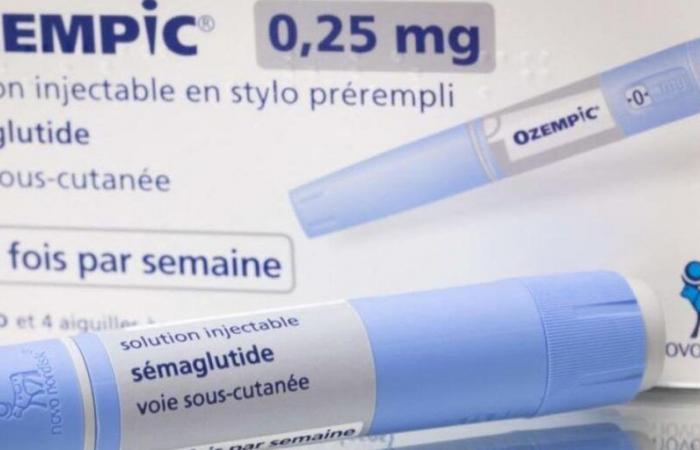Since 2023, the National Medicines Safety Agency (ANSM) and Health Insurance have issued alerts about the risk of misuse with the antidiabetic drug Ozempic (the name of the molecule is semaglutide), which has led to reinforced monitoring of prescriptions.
It is true that semaglutide has been popularized for misuse of its indication and outside of medical prescription to lose weight, particularly via the social network TikTok.
HAS read also:
Ozempic et peweight loss: the risks behind the misuse of this antidiabetic
Since October 2024, this same molecule has been made available at a higher dose, this time with an indication for treating obesity, under the brand name Wegovy. What about the risk of misuse today? We take stock.
A molecule that acts on blood sugar and appetite
Semaglutide is a GLP-1 analogue class agent (for glucagon-like peptide 1). This class of drugs is old: it was created in France in 2008; semaglutide appeared in 2018.
This class of drugs bears this name because these molecules reproduce the action of a hormone called GLP-1 which regulates the level of glucose in the blood (or blood sugar) as well as appetite and satiety, functions which are altered in type 2 diabetes. GLP-1 analogues have a very powerful antidiabetic effect, particularly semaglutide.
Dose-dependent effectiveness and adverse effects
Ozempic is administered by weekly self-injection using pre-filled syringes. But its intake may be associated with gastrointestinal intolerance. To limit this undesirable effect, administration must be done in progressive doses.
In people treated with drugs from the GLP-1 analog family, a reduction in weight is generally observed (even if there are non-responders) which is dose-dependent. This weight loss mainly involves regulating the appetite, without these pharmaceutical specialties being able to be described as “appetite suppressants”.
In addition, while older anorexigenic drugs may have caused cardiac events (and were banned for this reason), GLP-1 analogs, conversely, offer cardiovascular protection. This protection proves valuable because, in people who suffer from diabetes and obesity, it is the cardiovascular risk which is increased and which is most often life-threatening.
Since 2018, a dosage of 1 mg in diabetes with Ozempic
With Ozempic, semaglutide is used at a dose of 1 mg for the treatment of type 2 diabetes (obtained after two intermediate dose increases: 0.25 then 0.5 and finally 1 mg). This medication is reimbursed by Health Insurance.
It is in this diabetes that significant cardiovascular protection was first shown (with renal protection too, but to a lesser extent). This means that this treatment is prescribed for the long term because of its effectiveness, its safety and also the additional weight loss it causes, of the order of 5 to 10% on average.
In 2024, a dosage of 2.4 mg in obesity with Wegovy
At a dose this time of 2.4 mg (obtained after an increase in doses in 4 steps: 0.25; 0.5; 1; 1.7 and finally 2.4 mg), in obese subjects without diabetes, An average weight loss of just over 15% was shown after 68 weeks of treatment (STEP program). Cardiovascular protection has also been demonstrated in subjects also suffering from obesity with a history of cardiovascular diseases (SELECT study).
Wegovy was first made available at this dose in France as part of a strictly controlled procedure known as early access. This procedure was carried out pending its commercialization, and in a restrictive manner: in the most severe obesity (with a body mass index ≥ 40 kg/m) and with one or more complications.
Since October 8, 2024, Wegovy has been sold on medical prescription, at a price freely set by the manufacturer, without reimbursement by Health Insurance, and this time with a broader indication than the most severe obesity.
The manufacturer mentions an indication from grade 1 obesity (from a BMI of 30 kg/m) and even in overweight (with a BMI between 27 and 30 kg/m) but in the presence of at least one weight-related comorbidity factor (dysglycemia i.e. unbalanced blood sugar, dyslipidemia, high blood pressure, cardiovascular disease or obstructive sleep apnea syndrome).
Why reimburse Ozempic and not Wegovy?
If the antidiabetic Ozempic is reimbursed and not the anti-obesity Wegovy, it is because type 2 diabetes is a more serious disease than obesity (we speak of “high morbidity and mortality).
In type 2 diabetes, it is imperative to reduce high blood sugar levels, which are dangerous for the eyes, kidneys, and nerves, as well as cardiovascular risk. However, if the cardiovascular protection conferred by semaglutide is clearly demonstrated in diabetes – which justifies the reimbursement of the antidiabetic drug Ozempic – it is currently only in obesity in cases of vascular history. . Discussions for reimbursement of Wegovy in situations of obesity with a vascular history are also underway…
The problem of diversion of use
The manufacturer reported at the end of 2022 difficulties in supplying Ozempic for diabetic patients due to misuse. The medicines agency, for its part, in conjunction with Health Insurance, was establishing vigilance while putting things into perspective. Indeed, the proportion of non-diabetic people benefiting from Ozempic was estimated at around 1% at the end of 2022, with a reassessment to 1.4% at the end of May 2023.
Since such a low percentage is not likely to explain the supply difficulties in France, it would rather be appropriate to cite the enthusiasm for the molecule relayed by social networks, particularly in a highly populated Asia where the incidence of Obesity and diabetes follow the course of rapid development.
These epidemiological elements lead us to question, with regard to the supply tension, between the part linked to the increase in demand for diabetes (in which case there would be no misuse) and that of a truly misused treatment to lose weight beyond any medical control.
The drug agency and the supervision of GLP1 analogues
Following the marketing of Wegovy, the drug agency has positioned itself with the following recommendations:
-
Ozempic should only be prescribed in insufficiently controlled type 2 diabetes;
-
The initial prescription of Wegovy indicated against obesity is reserved for specialists in endocrinology-diabetology-nutrition, general practitioners can only renew the prescription;
-
The prescription of Wegovy must be done in accordance with the care pathway developed by the High Authority for Health (HAS), namely: “Adult patients with an initial BMI ≥ 35 kg/m and aged ≤ 65 years in the event of failure of the well-conducted nutritional care in association with a low-calorie diet and physical activity.”
What are the concrete risks associated with the misuse of this class of drugs?
-
At the individual level:
We have a long period of time to judge the side effects of GLP1 analogues. The most common are more annoying than serious. This concerns the gastrointestinal discomfort that we have already mentioned and an effect on appetite of varying intensity, from none to quite marked.
This reduction in appetite, if noted, would be welcome to reduce excessive energy intake, unless marked food deprivation is observed in a vulnerable subject. It is therefore important to ensure that weight loss does not also occur at the expense of muscle mass.
The drug agency also mentions hypoglycemia (or drops in blood sugar) among the potentially serious side effects. This hypoglycemic effect is observed when taking Ozempic reinforces the action of drugs which already have this effect (such as insulin or a sulphonamide). Concerning other more serious events which have been reported (pancreatitis, particular thyroid cancer and cardiac conduction disorder), their attributability to GLP-1 analogues remains very questionable.
The risk here is that of misuse the extent of which would limit access to Ozempic for diabetic subjects, especially if practices were developed to “force the dose” in order to increase the effect on weight. Certainly, there are several other classes of antidiabetic drugs. But semaglutide is the most powerful within the most powerful class and we sometimes lack the possibility of replacement when the treatment is already at its maximum.
As a reminder, semaglutide reduces both blood sugar and weight. When this molecule was only available for diabetes (with Ozempic), there was a great risk that it would be diverted to lose weight. Now that it is also available for obesity (with Wegovy), we can expect that the risk of misuse – to lose weight – will be lower, especially since the indications for Wegovy are now broader than when this drug was only available under early access.
On the other hand, the “timing” of Wegovy’s marketing is still unique in view of the supply tensions mentioned concerning the family of GLP-1 analogues, even if they are being resolved.
Additionally, the quantity of Wegovy made available by the manufacturer (Novo Nordisk) is not known. Finally, access to treatment will necessarily be limited due to its high cost, estimated at around 300 euros per month, without reimbursement by Health Insurance.
What about help in changing your lifestyle?
It is appropriate to raise a paradox here: the ANSM medicines agency is a national agency which recommends first changing lifestyle in obesity. But the State does not reimburse the measures which allow this modification, namely dietetic consultations and adapted physical activity (APA) sessions, and it does not promote psychology consultation and the activity of therapeutic education.
At the same time, negotiations are underway to obtain reimbursement for Wegovy…
We also dare to say that the State’s shortcomings, when it comes to measures to prevent obesity or its complications, are in themselves a factor of misuse.






